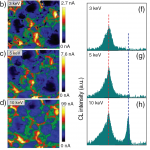 “High-resolution photocurrent microscopy using near-field cathodoluminescence of quantum dots”, H. P. Yoon, Y. Lee, C. D. Bohn, S. Ko, A. G. Gianfrancesco, J. S. Steckel, S. Coe-Sullivan, A. A. Talin, and N. B. Zhitenev, AIP Advances 3, 062112, 2013.
“High-resolution photocurrent microscopy using near-field cathodoluminescence of quantum dots”, H. P. Yoon, Y. Lee, C. D. Bohn, S. Ko, A. G. Gianfrancesco, J. S. Steckel, S. Coe-Sullivan, A. A. Talin, and N. B. Zhitenev, AIP Advances 3, 062112, 2013.
1. Center for Nanoscale Science and Technology, National Institute of Standards and Technology, Gaithersburg, MD 20899, USA
2. Maryland Nanocenter, University of Maryland, College Park, MD 20742, USA
3. Department of physics, Worcester Polytechnic Institute, Worcester, MA 01602, USA
4. QD Vision Inc., 29 Hartwell Ave., Lexington, MA 02421, USA
5. Sandia National Laboratories, Livermore, CA 94550, USA
ABSTRACT. We report a fast, versatile photocurrent imaging technique to visualize the local photo response of solar energy devices and optoelectronics using near-field cathodoluminescence (CL) from a homogeneous quantum dot layer. This approach is quantitatively compared with direct measurements of high-resolution Electron Beam Induced Current (EBIC) using a thin film solar cell (n-CdS / p-CdTe). Qualitatively, the observed image contrast is similar, showing strong enhancement of the carrier collection efficiency at the p-n junction and near the grain boundaries. The spatial resolution of the new technique, termed Q-EBIC (EBIC using quantum dots), is determined by the absorption depth of photons. The results demonstrate a new method for highresolution, sub-wavelength photocurrent imaging measurement relevant for a wide range of applications.

